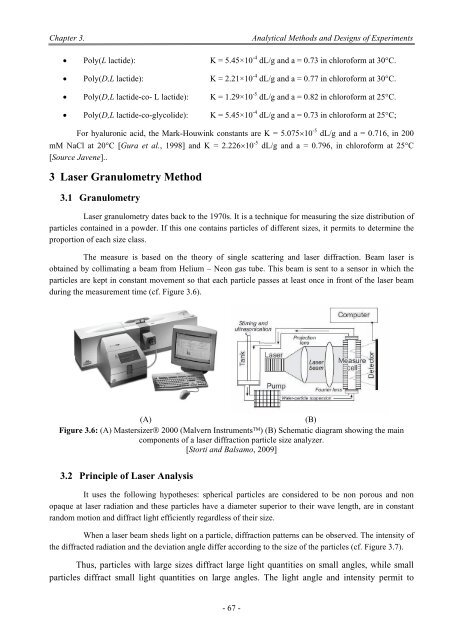Influence of the Processes Parameters on the Properties of The ...
Influence of the Processes Parameters on the Properties of The ...
Influence of the Processes Parameters on the Properties of The ...
Create successful ePaper yourself
Turn your PDF publications into a flip-book with our unique Google optimized e-Paper software.
Chapter 3.<br />
Analytical Methods and Designs <str<strong>on</strong>g>of</str<strong>on</strong>g> Experiments<br />
Poly(L lactide): K = 5.45×10 -4 dL/g and a = 0.73 in chlor<str<strong>on</strong>g>of</str<strong>on</strong>g>orm at 30°C.<br />
Poly(D,L lactide): K = 2.21×10 -4 dL/g and a = 0.77 in chlor<str<strong>on</strong>g>of</str<strong>on</strong>g>orm at 30°C.<br />
Poly(D,L lactide-co- L lactide): K = 1.29×10 -5 dL/g and a = 0.82 in chlor<str<strong>on</strong>g>of</str<strong>on</strong>g>orm at 25°C.<br />
Poly(D,L lactide-co-glycolide): K = 5.45×10 -4 dL/g and a = 0.73 in chlor<str<strong>on</strong>g>of</str<strong>on</strong>g>orm at 25°C;<br />
For hyalur<strong>on</strong>ic acid, <str<strong>on</strong>g>the</str<strong>on</strong>g> Mark-Houwink c<strong>on</strong>stants are K = 5.07510 -5 dL/g and a = 0.716, in 200<br />
mM NaCl at 20°C [Gura et al., 1998] and K = 2.22610 -5 dL/g and a = 0.796, in chlor<str<strong>on</strong>g>of</str<strong>on</strong>g>orm at 25°C<br />
[Source Javene]..<br />
3 Laser Granulometry Method<br />
3.1 Granulometry<br />
Laser granulometry dates back to <str<strong>on</strong>g>the</str<strong>on</strong>g> 1970s. It is a technique for measuring <str<strong>on</strong>g>the</str<strong>on</strong>g> size distributi<strong>on</strong> <str<strong>on</strong>g>of</str<strong>on</strong>g><br />
particles c<strong>on</strong>tained in a powder. If this <strong>on</strong>e c<strong>on</strong>tains particles <str<strong>on</strong>g>of</str<strong>on</strong>g> different sizes, it permits to determine <str<strong>on</strong>g>the</str<strong>on</strong>g><br />
proporti<strong>on</strong> <str<strong>on</strong>g>of</str<strong>on</strong>g> each size class.<br />
<strong>The</strong> measure is based <strong>on</strong> <str<strong>on</strong>g>the</str<strong>on</strong>g> <str<strong>on</strong>g>the</str<strong>on</strong>g>ory <str<strong>on</strong>g>of</str<strong>on</strong>g> single scattering and laser diffracti<strong>on</strong>. Beam laser is<br />
obtained by collimating a beam from Helium – Ne<strong>on</strong> gas tube. This beam is sent to a sensor in which <str<strong>on</strong>g>the</str<strong>on</strong>g><br />
particles are kept in c<strong>on</strong>stant movement so that each particle passes at least <strong>on</strong>ce in fr<strong>on</strong>t <str<strong>on</strong>g>of</str<strong>on</strong>g> <str<strong>on</strong>g>the</str<strong>on</strong>g> laser beam<br />
during <str<strong>on</strong>g>the</str<strong>on</strong>g> measurement time (cf. Figure 3.6).<br />
(A)<br />
(B)<br />
Figure 3.6: (A) Mastersizer 2000 (Malvern Instruments) (B) Schematic diagram showing <str<strong>on</strong>g>the</str<strong>on</strong>g> main<br />
comp<strong>on</strong>ents <str<strong>on</strong>g>of</str<strong>on</strong>g> a laser diffracti<strong>on</strong> particle size analyzer.<br />
[Storti and Balsamo, 2009]<br />
3.2 Principle <str<strong>on</strong>g>of</str<strong>on</strong>g> Laser Analysis<br />
It uses <str<strong>on</strong>g>the</str<strong>on</strong>g> following hypo<str<strong>on</strong>g>the</str<strong>on</strong>g>ses: spherical particles are c<strong>on</strong>sidered to be n<strong>on</strong> porous and n<strong>on</strong><br />
opaque at laser radiati<strong>on</strong> and <str<strong>on</strong>g>the</str<strong>on</strong>g>se particles have a diameter superior to <str<strong>on</strong>g>the</str<strong>on</strong>g>ir wave length, are in c<strong>on</strong>stant<br />
random moti<strong>on</strong> and diffract light efficiently regardless <str<strong>on</strong>g>of</str<strong>on</strong>g> <str<strong>on</strong>g>the</str<strong>on</strong>g>ir size.<br />
When a laser beam sheds light <strong>on</strong> a particle, diffracti<strong>on</strong> patterns can be observed. <strong>The</strong> intensity <str<strong>on</strong>g>of</str<strong>on</strong>g><br />
<str<strong>on</strong>g>the</str<strong>on</strong>g> diffracted radiati<strong>on</strong> and <str<strong>on</strong>g>the</str<strong>on</strong>g> deviati<strong>on</strong> angle differ according to <str<strong>on</strong>g>the</str<strong>on</strong>g> size <str<strong>on</strong>g>of</str<strong>on</strong>g> <str<strong>on</strong>g>the</str<strong>on</strong>g> particles (cf. Figure 3.7).<br />
Thus, particles with large sizes diffract large light quantities <strong>on</strong> small angles, while small<br />
particles diffract small light quantities <strong>on</strong> large angles. <strong>The</strong> light angle and intensity permit to<br />
- 67 -

















